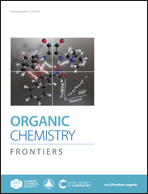Bifunctional squaramides with benzyl-like fragments: analysis of CH⋯π interactions by a multivariate linear regression model and quantum chemical topology†
Abstract
We analyzed 15 bifunctional squaramides with benzyl-like fragments in a Michael addition. These substituents are susceptible to form CH⋯π interactions and have distinct properties: electronic features, a stereogenic center, as well as additional cyclic groups which offer a more rigid moiety with a fixed orientation of the aryl group. We found that non-cyclic substituents, the benzyl group, had better selectivity than the chiral phenylethyl analog, and the electronic properties of the phenyl ring were not a decisive factor. The cyclic substituents also have different results. The non-chiral tricyclic groups were less selective because the orientation of the phenyl group has an undesirable arrangement to form the considered weak interactions. In contrast, the chiral 1-tetrahydronaphthyl group seemed to have the aryl ring in an optimal disposition. These trends were correlated using a multivariate linear regression model that considers the strength of CH⋯π contacts and the energy to adopt the “active” conformation to form these contacts. This model suggests that the most selective catalyst that incorporates commercially available 1-aminotetraline amine could be explained by the phenyl group already being in the optimal position which is its lowest energy conformation, and the phenyl ring has a double inductive effect from the vicinal alkyl groups. This catalyst was further explored and offered high selectivities across different nucleophiles and electrophiles. Finally, a quantum chemical topology analysis of the weak interactions revealed that the transition state that leads to the major enantiomer has an additional hydrogen bond with the nucleophile and a stronger association with the electrophile.



 Please wait while we load your content...
Please wait while we load your content...